Q1. Fill in the blanks using the correct option given in the bracket
(a) Employment in the service sector _________ increased to the same extent as production. (has / has not)
(b) Workers in the _________ sector do not produce goods. (tertiary / agricultural)
(c) Most of the workers in the _________ sector enjoy job security. (organised / unorganised)
(d) A _________ proportion of labourers in India are working in the unorganised sector. (large / small)
(e) Cotton is a _________ product and cloth is a _________ product. (natural / manufactured)
(f) The activities in primary, secondary and tertiary sectors are _________. (independent / interdependent)
Ans:
(a) Employment in the service sector has not increased to the same extent as production
(b) Workers in the tertiary sector do not produce goods.
(c) Most of the workers in the organized sector enjoy job security.
(d) A large proportion of labourers in India are working in the unorganized sector.
(e) Cotton is a natural product and cloth is a manufactured product.
(f) The activities in primary, secondary, and tertiary sectors are interdependent.
Q2. Choose the most appropriate answer.
(a) The sectors are classified into public and private sector on the basis of
(i) employment conditions.
(ii) the nature of economic activity.
(iii) ownership of enterprises.
(iv) number of workers employed in the enterprise.
Ans: (iii) ownership of enterprises
(b) Production of a commodity, mostly through the natural process, is an activity in ______________ sector.
(i) primary
(ii) secondary
(iii) tertiary
(iv) information technology
Ans: (i) primary
(c) GDP is the total value of _____________ produced during a particular year.
(i) all goods and services
(ii) all final goods and services
(iii) all intermediate goods and services
(iv) all intermediate and final goods and services
Ans: (ii) all final goods and services
(d) In terms of GDP the share of tertiary sector in 2003 is _________.
(i) between 20 percent to 30 percent
(ii) between 30 percent to 40 percent
(iii) between 50 percent to 60 percent
(iv) 70 percent
 Ans: (iii) between 50 percent to 60 percent
Ans: (iii) between 50 percent to 60 percent
Q3. Match the following
Ans:
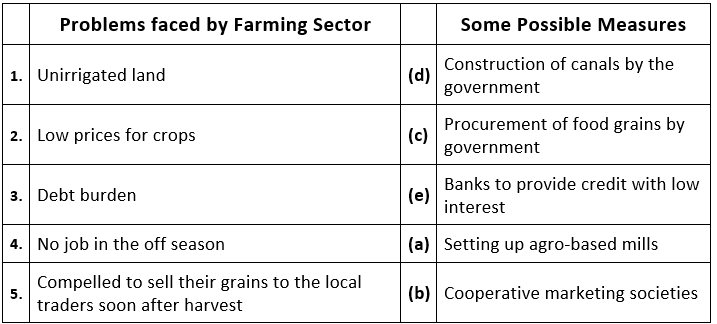
Q4. Find the odd one out and say why.
(i) Tourist guide, dhobi, tailor, potter
(ii) Teacher, doctor, vegetable vendor, lawyer
(iii) Postman, cobbler, soldier, police constable
(iv) MTNL, Indian Railways, Air India, Jet Airways, All India Radio
Ans:
(i) Tourist Guide
He is appointed by the government, while dhobi, tailor and potter belong to the private sector.
(ii) Vegetable Vendor
He is the only profession that does not require formal education.
(iii) Cobbler
The rest are workers in the public sector, while his profession is part of the private sector
(iv) Jet Airways
It is a private enterprise, while the rest are government undertakings.
Q5. A research scholar looked at the working people in the city of Surat and found the following.
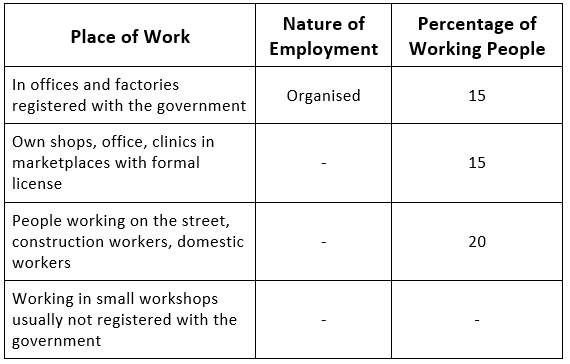
Complete the table. What is the percentage of workers in the unorganised sector in this city?
Ans:
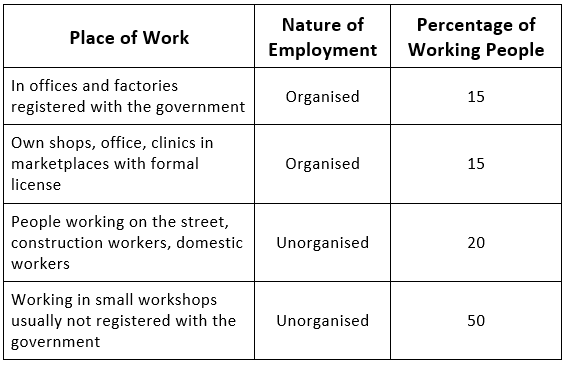
The percentage of workers in the unorganised sector in this city is 70%.
Q6. Do you think the classification of economic activities into primary, secondary, and tertiary is useful? Explain how.
Ans:
- The classification of economic activities into primary, secondary and tertiary is useful on account of the information it provides on how and where the people of a country are employed.
- Also, this helps in ascertaining as to which sector of economic activity contributes more or less to the country’s GDP and per capita income.
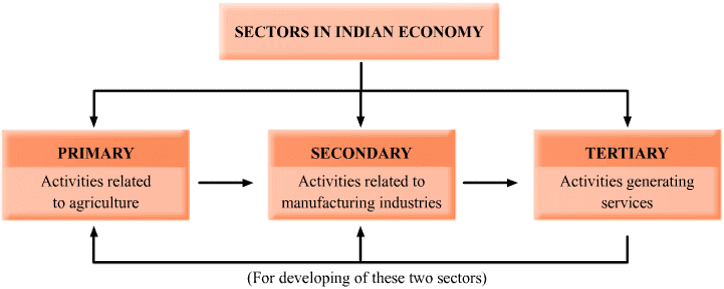 Classification of Economic Sectors
Classification of Economic Sectors
- If the tertiary sector is developing much faster than the primary sector, then it implies that agriculture is depleting, and the government must take measures to rectify this.
- The knowledge that the agricultural profession is becoming unpopular or regressive can only come if we know which sector it belongs to.
- Hence, it is necessary to classify economic activities into these three basic sectors for smooth economic administration and development.
Q7. For each of the sectors that we came across in this chapter, why should one focus on employment and GDP? Could there be other issues which should be examined? Discuss.
Ans:
- For each of the sectors that we came across in this chapter, one should focus on employment and GDP because these determine the size of a country’s economy.
- A focus on employment and GDP helps determine two important things—per capita income and productivity.
- Hence, in each of the three sectors, employment rate and status, as well as its contribution to the GDP, help us understand how that particular sector is functioning and what needs to be done to initiate further growth in it.
Q8. Make a long list of all kinds of work that you find adults around you doing for a living. In what way can you classify them? Explain your choice.
Ans: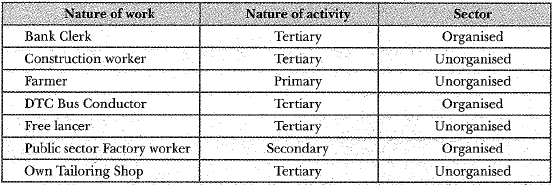 We have classified them according to the nature of the activity and according to their sector. This is a useful process as it is an easier way to layout the information.
We have classified them according to the nature of the activity and according to their sector. This is a useful process as it is an easier way to layout the information.
Q9. How is the tertiary sector different from other sectors? Illustrate with a few examples.
Ans:
- The tertiary sector is different from the other sectors because it does not manufacture or produce anything.
- For this reason, it is also known as the service sector.
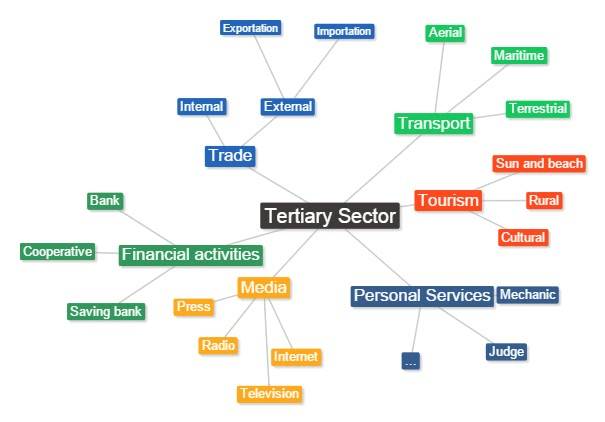
- It aids the primary and secondary sectors in development.
- The tertiary sector involves services like transport, storage of goods, communications, banking and administrative work.
Q10. What do you understand by disguised unemployment? Explain with an example each from the urban and rural areas.
Ans:
- Disguised unemployment is a form of underemployment where one has a job, but the work is divided.
- It is not apparent as compared to someone without a job who is clearly unemployed.
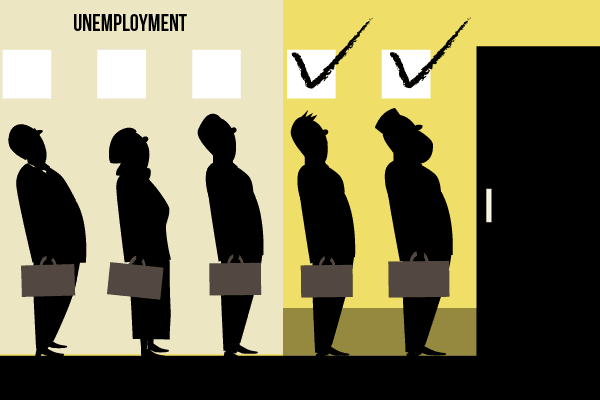
- In rural areas, this can be seen in the farming community where all members of a family might be working on a farm even though so many hands are not required.
- They do so because of lack of another job. In urban areas, disguised unemployment can be seen in the service sector where painters, plumbers, repairpersons and those doing odd jobs have work, but they may not find daily or regular employment.
Q11. Distinguish between open unemployment and disguised unemployment.
Ans:
- Open unemployment is when a person has no job in hand and does not earn anything at all.
- On the other hand, disguised unemployment is mostly found in the unorganised sector where either work is not consistently available or too many people are employed for some work that does not require so many hands.
- This is the essential difference between open unemployment and disguised unemployment.
Q12. “Tertiary sector is not playing any significant role in the development of Indian economy.” Do you agree? Give reasons in support of your answer.
Ans:
- “Tertiary sector is not playing any significant role in the development of the Indian economy”. This statement is not true.
- The tertiary sector has contributed vastly to the Indian economy, especially in the last two decades.
- In the last decade, the field of information technology has grown, and consequently, the GDP share of the tertiary sector has grown from around 40% in 1973 to more than 50% in 2003.
Q13. Service sector in India employs two different kinds of people. Who are these?
Ans:
(i)
- Service Sector in India employs highly skilled and educated people in multinational companies, public sector and several private enterprises.
- This sector enhances the economy of the country.
- They are an asset as they add up high income in the National Income of the country.
(ii)
- Low skilled and less educated people are also employed in the service sector, but most of them are uneducated.
- Therefore, they are working in unorganised sectors.
- They are employed as painters, plumbers, repairpersons, etc.
- They are doing this work because they do not have better opportunities.
Q14 Workers are exploited in the unorganised sector. Do you agree with this view? Give reasons in support of your answer.
Ans:
- Workers are exploited in the unorganised sector. I agree with this view. The unorganised sector does not offer any job security.
 Unorganised Sector
Unorganised Sector
- Neither does it allow for scope of trade or workers’ unions. Workers can be easily exploited in this scenario.
- They cannot afford to rebel against an employer’s tyranny as the latter can fire them at any time.
Q15. How are the activities in the economy classified on the basis of employment conditions?
Ans: They are mainly classified in two types:
(i) Organised
- The enterprises or place of work where the terms of employment are regular and therefore, people have assured work.
- They are registered by the government and have to follow its rules and regulations which are given in various laws such as the Factories Act, Minimum Wages Act, Payment of Gratuity Act, shops and establishments Act, etc. Workers enjoy security of employment.
- They work only fixed number of hours. If they work more, they get paid extra. Worker enjoys benefits like paid leave, Provident fund and medical benefits.
(ii) Unorganised
- The enterprises or place of work are not registered by the government and does not follow any rules or regulations.
- There are no terms of employment.
- Workers do not enjoy security of employment.
- There is no fixed number of hours.
- Workers do not enjoy any benefits.
Q16. Compare the employment conditions prevailing in the organised and unorganised sectors.
Ans:
- The employment conditions prevailing in the organised and unorganised sectors are vastly different.
- The organised sector has companies registered with the government and hence, it offers job security, paid holidays, pensions, health and other benefits, fixed working hours and extra pay for overtime work.
- On the other hand, the unorganised sector is a host of opposites.
- There is no job security, no paid holidays or pensions on retirement, no benefits of provident fund or health insurance, unfixed working hours and no guarantee of safe work environment.
Q17 Explain the objective of implementing the MGNREGA 2005.
Ans: The objective of implementing the MGNREGA 2005 are:
- To increase the income and employment of people.
- Every state/region can develop tourism, regional craft, IT, etc. for additional employment.
- The central government made a law implementing the right to work in 200 districts.
- MGNREGA aims to provide employment of 100 days. If it fails to do so, it will give unemployment allowances to the people.
Q18. Using examples from your area compare and contrast the activities and functions of private and public sectors.
Ans:
Q19. Discuss and fill the following table giving one example each from your area.

Ans:

Q20. Give a few examples of public sector activities and explain why the government has taken them up.
Ans:
AIIMS: To provide quality health services at a reasonable rate was the main purpose of the government to start this, besides medical education.
Railways: only the government can invest a large sum of money on a public project with long gestation period. And also to ensure and provide transportation at cheap rates.
Electronic Power Generation by NTPC: The government has taken this up to provide electricity at a reasonable rate to consumers.
Q21. Explain how public sector contributes to the economic development of a nation.
Ans:
- The public sector contributes to the economic development of a nation by not mere financial profits.
- The public sector plays a vital role in contributing to the Human Development Index via its functioning in health and education services.
- Also, by buying food grains at a “fair price” from farmers, providing electricity, water, postal services at low rates, the government ensures that the people have a good living.
- It utilises taxes and grants to pay for the same.
- Thus, it plays a vital role in adding to the economic development of a nation, based on its human development situation.
Q22. The workers in the unorganised sector need protection on the following issues: wages, safety and health. Explain with examples.
Ans:
- The workers in the unorganised sector need protection on the following issues: wages, safety, and health.
- In the construction sector, labourers are employed on a daily basis. Hence, they have no job security.
- Here, wages too differ from time to time. Consequently, the government has set up a minimum wages act to protect such workers from economic exploitation.
- The same problem exists for miners working in private mining companies.
- Their safety is secondary to the company’s profits, and as a result, many miners suffer grievous injuries (and many a time, even die) due to inadequate safety gear and norms.
- Governments of most nations have now laid down strict rules for private enterprises to ensure workers’ safety.
- Most companies in the unorganised sector do not provide health insurance to their employees.
- Some of these might be involved in dangerous factory production that may harm a worker’s health in the long term.
- These workers need to be protected against the tyranny of the employer, and it is here that the government steps in.
Q23. A study in Ahmedabad found that out of 15,00,000 workers in the city, 11,00,000 worked in the unorganised sector. The total income of the city in this year (1997-1998) was ₹60,000 million. Out of this ₹32,000 million was generated in the organised sector. Present this data as a table. What kind of ways should be thought of for generating more employment in the city?
Ans:

- It is clear that while a larger portion of workers is working in the unorganized sector, the percapita earning of those in the organized sector is more.
- The government should encourage entrepreneurs in the unorganized sector to change them into the organized sector.
- Moreover, the government should introduce some incentives so that more industries could be opened up in the organized sector.
Q24. The following table gives the GDP in Rupees (Crores) by the three sectors: (i) Calculate the share of the three sectors in GDP for 1950 and 2011.
(i) Calculate the share of the three sectors in GDP for 1950 and 2011.
(ii) Show the data as a bar diagram similar to Graph 2 in the chapter.
(iii) What conclusions can we draw from the bar graph?
Ans: (i) Share for 1950:
GDP (in ₹ crore) Share for 2011:
Share for 2011:

(ii)
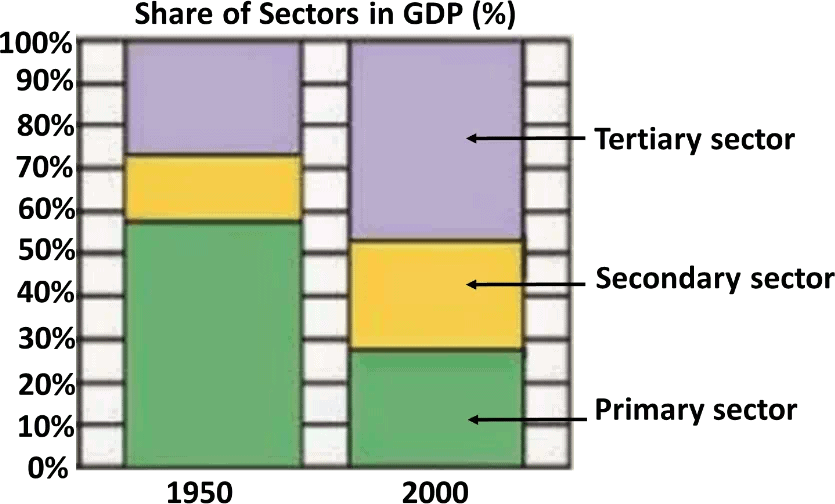 (iii) We can draw the conclusion that the share of the tertiary sector in the GDP has almost doubled, while that of the primary sector has declined by about 41% in the last six decades. The secondary sector has grown by about 13% in the last six decades.
(iii) We can draw the conclusion that the share of the tertiary sector in the GDP has almost doubled, while that of the primary sector has declined by about 41% in the last six decades. The secondary sector has grown by about 13% in the last six decades.

No comments:
Post a Comment